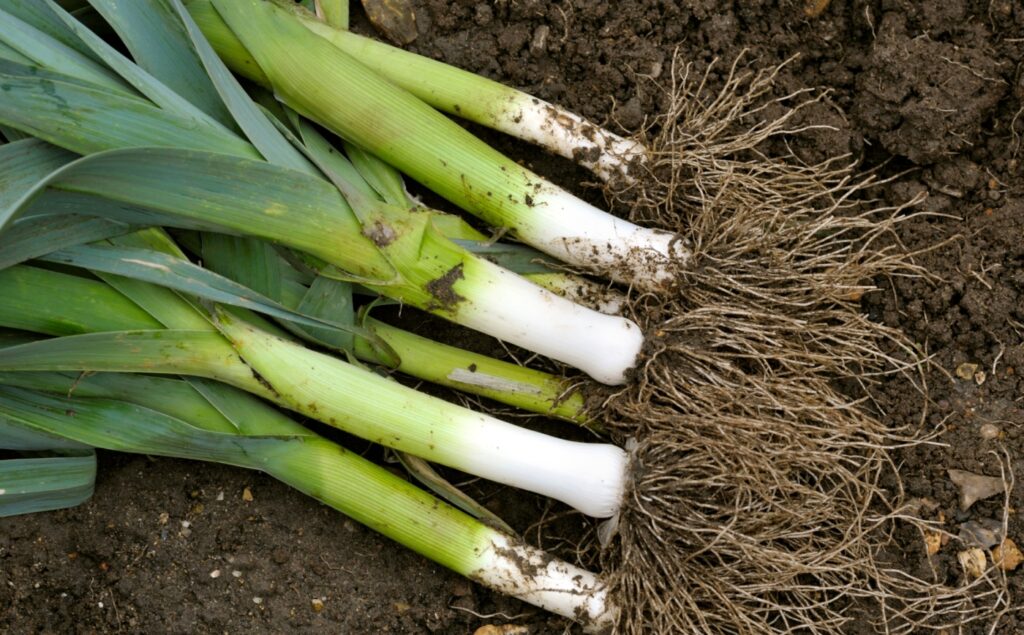
1. Fertilize trees and shrubs with phosphorus and potassium, but not with nitrogen. Root systems of trees and shrubs do most of their growing in the fall. Even as air temperatures cool, the soil remains warm from the summer, encouraging root growth, especially now that foliar growth is shutting down. Phosphorus encourages root growth and potassium strengthens plants’ immune systems to give them more resistance to pests, drought, and cold weather. Nitrogen, on the other hand, encourages leaf and shoot growth which is not desirable at this time since a sudden night of cold weather could damage that growth.
2. You can plant leeks now. Depending on variety, they take two to four months until they are ready for harvest, but may be stored in the ground for many months after that. Leeks grow fine as long as it does not freeze so except for those occasional frosts every few years in the greater Los Angeles area, you should not have any problems. Occasionally you see young leek seedlings in the nursery but you can also start them from seed. To expedite the germination process, procure a seedling heat mat for $15-20 from an online vendor. It will make seed germination a much more reliable procedure than when you plant seeds directly in the garden. Place your seeds in Styrofoam or Dixie cups (with holes punched in the bottom), or nursery six-pack or four-inch plastic containers, with a plastic or rubber tray underneath. The only caveat is to remove the seedlings not long after germination. Otherwise, they could roast. Plant your leek seedlings in the garden bed spaced six inches apart at a depth that covers the bottom white part of the stem. As the plants develop, mounding up soil around the lower stems will keep them white.
3. As deciduous tree leaves turn to gold – such as those on ash, sycamore, and liquidambar trees – regard them as such. Each leaf is a treasure trove of minerals so plants growing in soil that is always covered with a thick layer of leaf mulch will not require fertilization. Remember: We can build and maintain a beneficial layer of mulch around our plants as thick as four inches, so if we are blessed with deciduous trees that provide free leaf mulch we may as well utilize it for this purpose. Not only will the soil be enriched with a continuous mineral feed as mulch decomposes into humus, but evaporative water loss from the soil will be minimized due to the blanket of mulch that covers it. As a bonus, weeds will seldom, if ever, appear.
Related Articles
Try growing these vegetables and plants in your garden this fall
How a heatwave can affect when your trees bear fruit
Growing redwood and sequoia trees in Southern California gardens
Vegetables, bulbs and more: What to do in the garden this week
How to care for indoor plants as summer heads into fall
4. If you have a plant that has struggled due to too much sun (indicated by burnt leaves) or too much shade (indicated by elongated growth and few flowers), now is a good time to move it to a more favorable location. Roots will grow well in soil still warm from the summer even as cooler weather means less stress – for both plants and gardeners – as soil moisture content ceases to be a daily concern. Make sure you dig up a root ball that entirely encompasses the root system in the top six inches of soil and most of it to a depth of a foot. Before moving it – if it’s a shrub or small tree – you might want to wrap the root ball in a burlap tarp (available at lawnmower shops) to make sure it’s kept intact while moving it to another spot in your garden.
If you are not certain which exposure is most suitable for a plant you bring home from the nursery, dig a hole that matches the size of its container and then plant it there, container and all. If the plant thrives where you placed it, remove it from the container and plant it back in the hole, but if it flounders you can comfortably move it somewhere else while still in its container. Before you plant, make an assessment of the amount of sun available in that spot throughout the year, not just at the time you are planting it.
5. Now is an excellent time to plant wildflower seeds for winter and spring bloom. The Theodore Payne Foundation has a collection of 67 different California wildflower seed species and the knowledgeable nursery staff will help you decide which are most suitable for your garden. Seeds germinate more easily in warm soil which makes fall a more desirable season to plant them than winter, by which time most of the heat absorbed from summer’s sun has dissipated. Make sure that mountain garland (Clarkia unguiculata) is one of your native seed choices. Flowers are salmon, pink, magenta, red, or purple and consist of four discrete stingray-shaped petals; double flowers are often encountered. Distinctive red stems may reach five feet in height. Flowers attract bees, butterflies, and hummingbirds and are suitable for vase arrangements.
Send comments, questions, or photos to Joshua@perfectplants.com.
